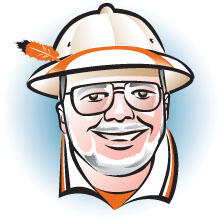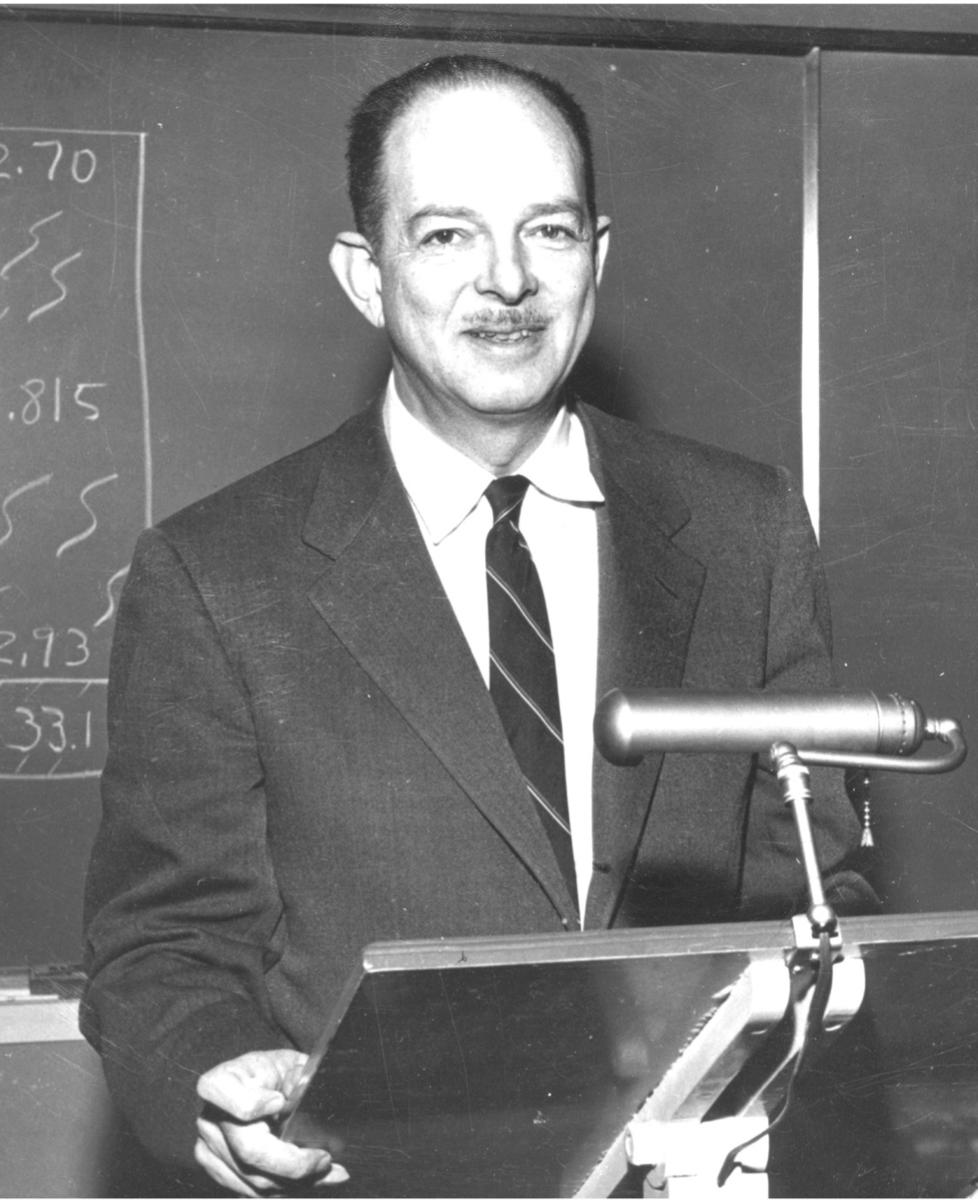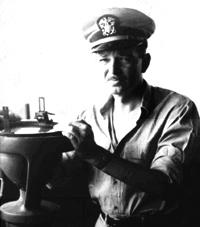From moon rocks to the ocean's depths
Professor Harry Hess *32 revolutionized the geological sciences
So they just proved there’s water on the moon. This is fascinating – even beyond the heartening fact that we haven’t forgotten how to get a spacecraft up there – because Professor Harry Hammond Hess *32 knew there was water there, and he knew it 50 years ago. He was the esteemed chairman of the Space Science Board of the National Academy of Sciences when we landed in 1969; earlier in the decade, as the idea had surfaced about sending real scientists to the moon along with the jet jockeys, he was not only one of the instigators, but one of the first seriously suggested as a candidate. To understand how extraordinary he was, consider that he would have been 63 at the time.
You might also keep in mind that this wasn’t his day job.
Until Harry Hess revolutionized them in 1960, the geological sciences were something of a 20th-century century afterthought. Darwin had biology zipping along; Freud had essentially invented his own scientific branch; Einstein had sent physics leaping ahead (perhaps too far); Crick and Watson and their double helix turned biochemistry toward unrecognizable possibilities; there was the transistor and the computer – but rocks were pretty much still rocks. Not that there hadn’t been glimmers: German Alfred Wegener in 1912 posited the seemingly ridiculous theory of continental drift, but nobody picked up the mantle (as it were). The idea that the massive continents somehow were moving across the world’s sea floors was treated dismissively; the single resulting conference on the subject in the United States was held expressly to oppose the idea.
Hess was in grad school at Princeton when Wegener died in 1931, and not a lot happened publicly in geology while Hess literally marshaled his forces over the next 30 years. His dissertation led him to submarine seafloor exploration in the Caribbean in the 1930s while teaching at Princeton; his badgering of the captains to order the adjustment of depth for readings led the Navy to make him a reserve lieutenant junior grade so he could just do it himself. So as a naval officer, on Dec. 8, 1941, he hopped on the train to New York in his only uniform for what became four years of naval duty. Sort of.
After using his precise scientific mind to help predict the routes of German U-boats – they always followed resource-efficient paths, a formula that didn’t work for tracking Italian subs – he made for the Pacific, where he was given command of an attack transport ship. Not by coincidence, he made sure it was equipped with gear for sounding the ocean bottom. While he saw quite a bit of action, including four landings on Japanese-held islands, he saw even more of the Pacific floor, mapping almost 250,000 miles of it (ostensibly under orders) by war’s end. Among other discoveries, he detailed curious mountains more than a mile beneath the sea that had been worn flat – by wind and rain. Although unable to explain them adequately, he knew something important when he saw it, and gave them a special name: They were “guyots” for the great Arnold Guyot, founder of the Princeton geology department and namesake of Guyot Hall. Hess emerged from World War II more knowledgeable of underwater geology than any other scientist on the planet, and it paid off.
While remaining a captain in the naval reserve, he reinvolved himself at Princeton with verve; by 1950 he had succeeded his mentor, Arthur Buddington *16, as geology department chairman; in 1952 he was elected to the National Academy of Sciences along with Princetonians Lyman Spitzer *38 and John Wheeler. His well-developed administrative skills brought a deluge of roles beyond his chairmanship: He was promoted to rear admiral (apparently a first for a Princeton alum), he was on the Princeton Committee of Three, he was on the faculty committee that helped select Robert Goheen ’40 *48 as president, and he served terms as president of two sections of the American Geophysical Union, the Mineralogical Society of America, and the Geological Society of America. His analogizing of apparent moon geography to earth features and geologic processes (he was certain some moon bulges bespoke subterranean water) earned him an increasingly responsible spot in space science, although his occupational focus increasingly was underwater.
By the mid-’50s he had Princeton grad students scouring the Caribbean for every worthwhile geological feature they could dredge up for a dissertation, enriching his vast knowledge of the peculiarities of the seafloor: It was much younger than most land masses, and it had different geologic structure and precipitous drops that seemed problematic – guyots near them were tilted for some reason. At some point in the late ’50s, in the midst of all his activities, the overarching answer to the seafloor problems – and much more – came to him, although he never recalled how. New land was being created by molten upheavals along the fresh ridges beneath the oceans, in turn pushing existing land toward the deep trenches where it eventually ground its way beneath adjacent land masses. The effect was the entire surface of the earth being composed of 20 or so huge crust plates, arising from the ocean bottom and diving beneath adjacent plates, but always on the move. The guyots, long previously above the water surface, were inexorably on their way down to a subterranean fate, and the continents, which indeed once had been a huge single mass as Wegener had theorized, were drifting in various directions on top of the plates. This description of seafloor spreading and plate tectonics, first reduced to writing by Hess in a paper to the Navy in 1960, is a stunning explanation for Wegener’s continental drift, seismic fault lines, volcanic clusters, and many other geologic phenomena that has reigned effectively unchallenged for 50 years. In many ways, it’s so overwhelming and pervasive that those of us who have grown up since can’t imagine it took so long to identify, that our parents had no sense of the plates. The synthesis of the powerful idea is a piece of simple beauty on a level with e=mc2 or the DNA double helix.
Harry Hess, a lifelong chain-smoker, died of a heart attack at age 63 in Woods Hole at a triumphant meeting of his Space Science Board only one month after the first manned landing on the moon. He was in charge of distributing many of the moon rocks, but didn’t live to analyze the one in his own lab. The Princeton faculty’s resolution at its next meeting addressed the magic of his approach to geology: “Withal, Harry Hess had a deep, almost a religious reverence for the awesome order of the universe. He possessed that combination of driving urge to discover truth and a profound humility before the vast truths yet unknown which is the mark of the truly creative scholar.”
The music of the spheres indeed, or at the very least the age-old hymn of the plates.















No responses yet